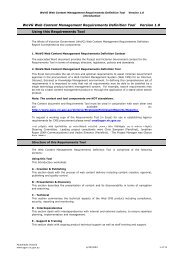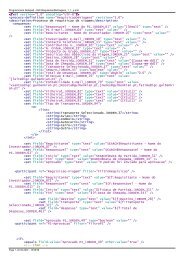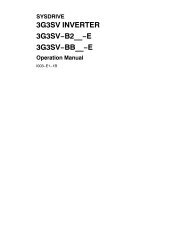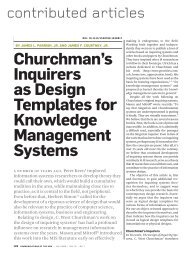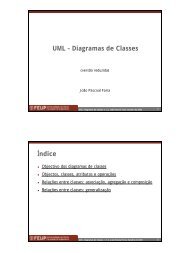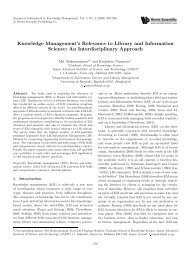Measuring Knowledge Management Cycle: Evidence from Iran
Measuring Knowledge Management Cycle: Evidence from Iran
Measuring Knowledge Management Cycle: Evidence from Iran
- No tags were found...
You also want an ePaper? Increase the reach of your titles
YUMPU automatically turns print PDFs into web optimized ePapers that Google loves.
299 Hassan Danaee Fard and Minoo SelselehMichael Polani develops the notion of tacit knowledge. He uses Ryle's distinction between'knowing how' and 'knowing what' and suggests that each aspect of knowing is ever present with theother. They are not distinct entities and his assumption is that they exist together along a continuum.Burrel and Morgan (1979) have left a lasting legacy in the field of organizational studies bydeveloping our understanding of production of knowledge(Jashapara,2004).Drucker (1999) introduces explicit information and knowledge as a source for organization andSenge (1994) points to learning organization, which is the cultural dimension of knowledgemanagement (Drucker,1995).To Nonaka (1994), in every company there are two kinds of knowledge: tacit knowledge, andexplicit knowledge. Tacit knowledge consists of one's mental models, beliefs and opinions, and is rare,irreplaceable, inimitable, and precious knowledge sharing changes tacit knowledge to explicitknowledge. Explicit knowledge is a kind of knowledge which can be defined and shared easily throughinformation technology.According to Subi, every kind of knowledge is either tacit, or has its roots in tacit knowledge.He believes as well that tacit and explicit knowledge complete each other.Mac loop (1994), classifies knowledge into six types: practical knowledge, mental knowledge,amusement knowledge, abstract knowledge, and ordinary knowledge.Ghashal (1995) considers three types for knowledge: practical, experience-based, and theoricalknowledge. Rale (1994) believes knowledge to be procedure knowledge, and know howknowledge(Jashapara,2004).Some authors, such as Grant (1996b) and Nonaka et al (2001), claim that knowledge is themain source of sustainable competitive advantage.In the business context, knowledge can be defined as relevant information that is applied andthat is based partially on experience (Leonard-Barton, D. 1995, Leonard and Sensiper, 1998).Nevertheless, knowledge, especially its tacit dimension, is embedded in the individual and to bea source of competitive advantage it must be transformed into organizational knowledge (Grant, 1996a,b; Nonaka and Konno, 1998; Teece, 1998; Powell, 1998). This is the essence of knowledgemanagement and to achieve this goal, organizations must provide a context of shared identity thatfavors this process (Kogut and Zander, 1996; Von Krogh, G. (1998).3. The Emergence of <strong>Knowledge</strong> Revolution to DruckerTo Drucker, meaning of knowledge radically changed in 1700, which itself led to birth and emergenceof four revolution: industrial revolution (1770-1880), productivity revolution (1881-1960),management revolution (1960-1995) and during 1990's, simultaneous impacts of Internet and Digitalrevolution, led to emergence of fourth revolution which is knowledge revolution (1995-?). It wasthrough this revolution which organizations became aware of the importance of "becoming aware ofwhat they know". Organizations grasp this fact that without proper knowledge management,knowledge utilization would be impossible. And before knowledge documentation, and properorganizing, companies would not be able to become aware of their knowledge gap (Jashapara,2004).4. Review of the KM ModelsThe existing KM models encompass a broad range of issues, methods and theories that differ in scopeand focus. In order to make sense of this variety, several authors have attempted to summarize andcategorize diverse approaches (Holsapple & Joshi, 1999; McAdam & McCreedy, 1999; Alavi &Leidner, 2001; Earl, 2001; Kakabadse et al., 2003). This review identifies the following majorgroupings: First, there is a group of knowledge-oriented models such as those coming <strong>from</strong> theintellectual capital (IC) work of Sveiby (1997), McAdam & McCreedy (1999) and the economicschool in Earl's (2001) taxonomy. The list of knowledge types (e.g., explicit, tacit, what, how) andperspectives (e.g., administrative, epistemological, economical) elaborated in Alavi & Leidner's (2001)



